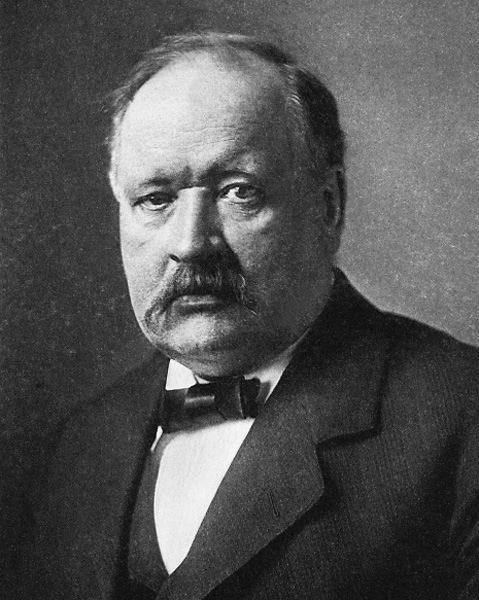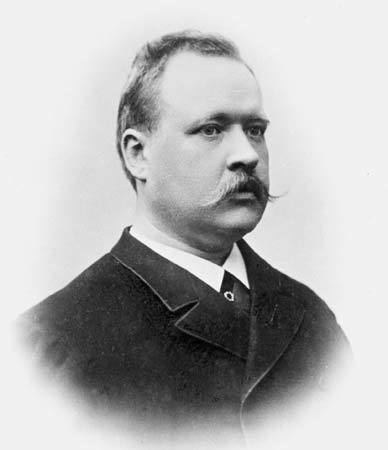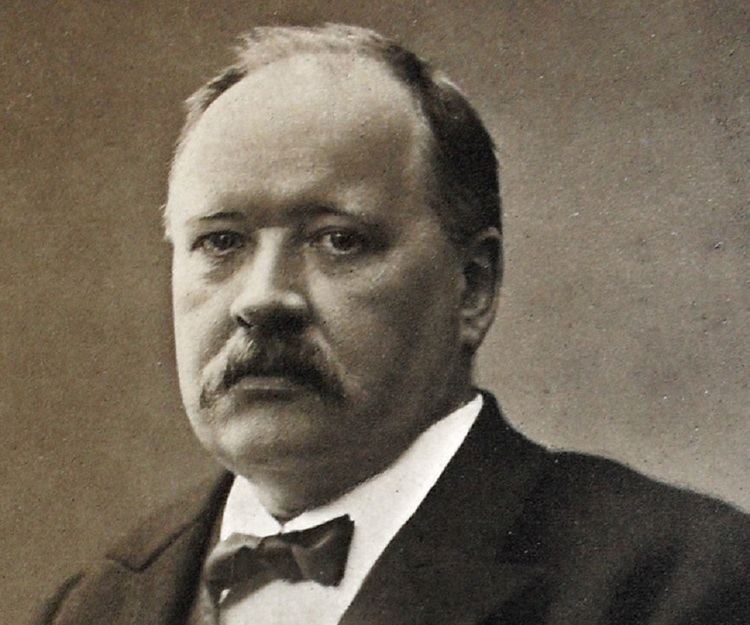Nationality Swedish Role Scientist Name Svante Arrhenius | Fields PhysicsChemistry Children Olof Arrhenius | |
 | ||
Born Svante August Arrhenius19 February 1859Wik Castle, Sweden ( 1859-02-19 ) Institutions Royal Institute of Technology Doctoral advisor Per Teodor CleveErik Edlund Spouse Maria Johansson (m. 1905–1927), Sofia Rudbeck (m. 1894–1896) Parents Carolina Thunberg Arrhenius, Svante Gustav Books Worlds in the Making: The Evol, Theories of Solutions, The Life of the Universe, The Life of the Universe, Lehrbuch der Kosmisch Similar People Johannes Nicolaus Bronsted, Erik Edlund, Per Teodor Cleve, Oskar Klein, Knut Lundmark | ||
Svante arrhenius google
Svante August Arrhenius (19 February 1859 – 2 October 1927) was a Nobel-Prize winning Swedish scientist, originally a physicist, but often referred to as a chemist, and one of the founders of the science of physical chemistry. He received the Nobel Prize for Chemistry in 1903, becoming the first Swedish Nobel laureate, and in 1905 became director of the Nobel Institute where he remained until his death. His lasting contributions to science are exemplified and memorialized by the Arrhenius equation, Arrhenius definition of an acid, lunar crater Arrhenius, the mountain of Arrheniusfjellet and the Arrhenius Labs at Stockholm University, all named after him. He was the first to use basic principles of physical chemistry to calculate estimates of the extent to which increases in atmospheric carbon dioxide increase Earth's surface temperature through the Arrhenius effect, leading David Keeling to conclude that human-caused carbon dioxide emissions are large enough to cause global warming.
Contents
- Svante arrhenius google
- Svante arrhenius experiment
- Early years
- Ionic disassociation
- Middle period
- Later years
- Greenhouse effect
- References

Svante arrhenius experiment
Early years

Arrhenius was born on 19 February 1859 at Vik (also spelled Wik or Wijk), near Uppsala, Sweden, the son of Svante Gustav and Carolina Thunberg Arrhenius. His father had been a land surveyor for Uppsala University, moving up to a supervisory position. At the age of three, Arrhenius taught himself to read without the encouragement of his parents, and by watching his father's addition of numbers in his account books, became an arithmetical prodigy. In later life, Arrhenius enjoyed using masses of data to discover mathematical relationships and laws.

At age eight, he entered the local cathedral school, starting in the fifth grade, distinguishing himself in physics and mathematics, and graduating as the youngest and most able student in 1876.
Ionic disassociation
At the University of Uppsala, he was dissatisfied with the chief instructor of physics and the only faculty member who could have supervised him in chemistry, Per Teodor Cleve, so he left to study at the Physical Institute of the Swedish Academy of Sciences in Stockholm under the physicist Erik Edlund in 1881.

His work focused on the conductivities of electrolytes. In 1884, based on this work, he submitted a 150-page dissertation on electrolytic conductivity to Uppsala for the doctorate. It did not impress the professors, among whom was Cleve, and he received a fourth-class degree, but upon his defense it was reclassified as third-class. Later, extensions of this very work would earn him the 1903 Nobel Prize in Chemistry.

Arrhenius put forth 56 theses in his 1884 dissertation, most of which would still be accepted today unchanged or with minor modifications. The most important idea in the dissertation was his explanation of the fact that solid crystalline salts disassociate into paired charged particles when dissolved, for which he would win the 1903 Nobel Prize in Chemistry. Arrhenius' explanation was that in forming a solution, the salt disassociates into charged particles, to which Michael Faraday had given the name ions many years earlier. Faraday's belief had been that ions were produced in the process of electrolysis, that is, an external direct current source of electricity was necessary to form ions. Arrhenius proposed that, even in the absence of an electric current, aqueous solutions of salts contained ions. He thus proposed that chemical reactions in solution were reactions between ions.
The dissertation did not impress the professors at Uppsala, but Arrhenius sent it to a number of scientists in Europe who were developing the new science of physical chemistry, such as Rudolf Clausius, Wilhelm Ostwald, and J. H. van 't Hoff. They were far more impressed, and Ostwald even came to Uppsala to persuade Arrhenius to join his research team. Arrhenius declined, however, as he preferred to stay in Sweden for a while (his father was very ill and would die in 1885) and had received an appointment at Uppsala.
In an extension of his ionic theory Arrhenius proposed definitions for acids and bases, in 1884. He believed that acids were substances that produce hydrogen ions in solution and that bases were substances that produce hydroxide ions in solution.
Middle period
In 1885 Arrhenius next received a travel grant from the Swedish Academy of Sciences, which enabled him to study with Ostwald in Riga (now in Latvia), with Friedrich Kohlrausch in Würzburg, Germany, with Ludwig Boltzmann in Graz, Austria, and with van 't Hoff in Amsterdam.
In 1889 Arrhenius explained the fact that most reactions require added heat energy to proceed by formulating the concept of activation energy, an energy barrier that must be overcome before two molecules will react. The Arrhenius equation gives the quantitative basis of the relationship between the activation energy and the rate at which a reaction proceeds.
In 1891 he became a lecturer at the Stockholm University College (Stockholms Högskola, now Stockholm University), being promoted to professor of physics (with much opposition) in 1895, and rector in 1896.
He was married twice, first to his former pupil Sofia Rudbeck (1894 to 1896), with whom he had one son Olof Arrhenius, and then to Maria Johansson (1905 to 1927), with whom he had two daughters and a son.
About 1900, Arrhenius became involved in setting up the Nobel Institutes and the Nobel Prizes. He was elected a member of the Royal Swedish Academy of Sciences in 1901. For the rest of his life, he would be a member of the Nobel Committee on Physics and a de facto member of the Nobel Committee on Chemistry. He used his positions to arrange prizes for his friends (Jacobus van't Hoff, Wilhelm Ostwald, Theodore Richards) and to attempt to deny them to his enemies (Paul Ehrlich, Walther Nernst, Dmitri Mendeleev). In 1901 Arrhenius was elected to the Swedish Academy of Sciences, against strong opposition. In 1903 he became the first Swede to be awarded the Nobel Prize in chemistry. In 1905, upon the founding of the Nobel Institute for Physical Research at Stockholm, he was appointed rector of the institute, the position where he remained until retirement in 1927. He was elected a Foreign Member of the Royal Society (ForMemRS) in 1910. In 1911 he won the first Willard Gibbs Award. " In 1912, he was elected a Foreign Honorary Member of the American Academy of Arts and Sciences In 1919 he became foreign member of the Royal Netherlands Academy of Arts and Sciences.
Later years
Eventually, Arrhenius' theories became generally accepted and he turned to other scientific topics. In 1902 he began to investigate physiological problems in terms of chemical theory. He determined that reactions in living organisms and in the test tube followed the same laws.
In 1904 he delivered at the University of California a course of lectures, the object of which was to illustrate the application of the methods of physical chemistry to the study of the theory of toxins and antitoxins, and which were published in 1907 under the title Immunochemistry. He also turned his attention to geology (the origin of ice ages), astronomy, physical cosmology, and astrophysics, accounting for the birth of the solar system by interstellar collision. He considered radiation pressure as accounting for comets, the solar corona, the aurora borealis, and zodiacal light.
He thought life might have been carried from planet to planet by the transport of spores, the theory now known as panspermia. He thought of the idea of a universal language, proposing a modification of the English language.
He was a board member for the Swedish Society for Racial Hygiene (founded 1909), which endorsed mendelism at the time, and contributed to the topic of contraceptives around 1910. However, until 1938 information and sale of contraceptives was prohibited in Sweden. Around 1930, conservative members of the society helped to establish eugenic policies in Sweden. Gordon Stein wrote that Svante Arrhenius was an atheist. In his last years he wrote both textbooks and popular books, trying to emphasize the need for further work on the topics he discussed. In September 1927 he came down with an attack of acute intestinal catarrh and died on 2 October. He was buried in Uppsala.
Arrhenius was the grandfather of bacteriologist Agnes Wold.
Greenhouse effect
In developing a theory to explain the ice ages, Arrhenius, in 1896, was the first to use basic principles of physical chemistry to calculate estimates of the extent to which increases in atmospheric carbon dioxide (CO2) will increase Earth's surface temperature through the greenhouse effect. These calculations led him to conclude that human-caused CO2 emissions, from fossil-fuel burning and other combustion processes, are large enough to cause global warming — This conclusion has been extensively tested, winning a place at the core of modern climate science. Arrhenius, in this work, built upon the prior work of other famous scientists, including Joseph Fourier, John Tyndall or Claude Pouillet. Arrhenius used infrared observations of the moon — by Frank Washington Very and Samuel Pierpont Langley at the Allegheny Observatory in Pittsburgh — to calculate how much of infrared (heat) radiation is captured by CO2 and water (H2O) vapour in Earth's atmosphere. Using 'Stefan's law' (better known as the Stefan-Boltzmann law), he formulated what he referred to as a 'rule'. In its original form, Arrhenius' rule reads as follows:
The following formulation of Arrhenius' rule is still in use today:
where
Based on information from his colleague Arvid Högbom, Arrhenius was the first person to predict that emissions of carbon dioxide from the burning of fossil fuels and other combustion processes were large enough to cause global warming. In his calculation Arrhenius included the feedback from changes in water vapor as well as latitudinal effects, but he omitted clouds, convection of heat upward in the atmosphere, and other essential factors. His work is currently seen less as an accurate quantification of global warming than as the first demonstration that increases in atmospheric CO2 will cause global warming, everything else being equal.
Arrhenius' absorption values for CO2 and his conclusions met criticism by Knut Ångström in 1900, who published the first modern infrared absorption spectrum of CO2 with two absorption bands, and published experimental results that seemed to show that absorption of infrared radiation by the gas in the atmosphere was already "saturated" so that adding more could make no difference. Arrhenius replied strongly in 1901 (Annalen der Physik), dismissing the critique altogether. He touched on the subject briefly in a technical book titled Lehrbuch der kosmischen Physik (1903). He later wrote Världarnas utveckling (1906) (German: Das Werden der Welten [1907], English: Worlds in the Making [1908]) directed at a general audience, where he suggested that the human emission of CO2 would be strong enough to prevent the world from entering a new ice age, and that a warmer earth would be needed to feed the rapidly increasing population:
At this time, the accepted consensus explanation is that, historically, orbital forcing has set the timing for ice ages, with CO2 acting as an essential amplifying feedback. However, CO2 releases since the industrial revolution have increased CO2 to a level not found since 10 to 15 million years ago, when the global average surface temperature was up to 11 °F warmer than now and almost all ice had melted, raising world sea-levels to about 100 feet higher than today's.
Arrhenius estimated based on the CO2 levels at his time, that reducing levels by 0.62 – 0.55 would decrease temperatures by 4–5 °C (Celsius) and an increase of 2.5 to 3 times of CO2 would cause a temperature rise of 8–9 °C in the Arctic. In his book Worlds in the Making he described the "hot-house" theory of the atmosphere.
